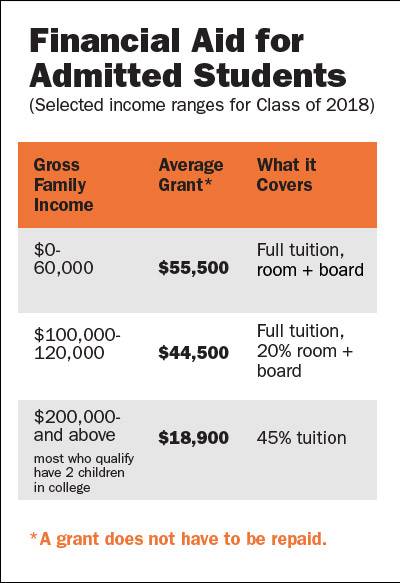Princeton University trustees Jan. 31 approved the University's operating budget for 2015-16, which includes a 7.4 percent increase to $140.2 million in the undergraduate financial aid budget for next year.
The University's pioneering financial aid program provides the assistance necessary to make sure that any student who is admitted and needs financial aid can attend. The aid comes in the form of grants, which do not need to be repaid. Approximately 60 percent of all undergraduate students receive aid, and the average grant is more than $40,000 per year. Because no student is required to take out loans, Princeton's aid program allows its students to graduate debt free.
"Our increased financial aid budget will maintain Princeton's commitment to full access for any student who is admitted, regardless of ability to pay and without the need for loans," Provost David Lee said. "Typically, students from families with the U.S. median household income of $54,000 pay no tuition and their average grant also covers room, board and other expenses. Most students from families with incomes up to $140,000 pay no tuition, and for an average family with income around $160,000, grant support would cover roughly 80 percent of tuition."
Lower net cost
Lee noted that Princeton's scholarship spending has outpaced fee increases for 14 of the last 15 years and its average annual fee package increase has been among the lowest in the nation for the past 18 years.
"As a result, when adjusted for inflation, the average net tuition, room and board for Princeton students on aid today — $13,072 — is 31 percent lower than it was in 2001," Lee said.

Princeton's commitment to access is also reflected in more than doubling the percentage of students receiving Pell grants, to 18 percent for the freshman Class of 2018, up from 7.2 percent for the freshman Class of 2008, Lee said.
The budget includes a 3.9 percent increase in undergraduate tuition to $43,450. Even with the increase, Princeton's total fee package, including tuition, room and board, is likely to be the lowest in its peer group. For the 2015-16 year, Princeton's full package of $57,610 will be about $630 below the lowest current year (2014-15) fee package of its closest competitors.
The increase in the financial aid budget will fully cover the increase in charges for any students receiving financial aid. Students receiving any level of aid will automatically receive an increase in aid to cover their full financial need. The projected average grant for an undergraduate student on financial aid in next year's freshman class is $46,350.

Solid financial footing
President Christopher L. Eisgruber presented the budget proposal to the trustees during a meeting Jan. 31. The proposal was based on the recommendations of the Priorities Committee of the Council of the Princeton University Community, which is made up of faculty, students and staff, and chaired by the provost.
Lee said that while the University is on solid financial footing, it is important to use resources efficiently to fund the University's priorities.
The approved budget includes funding for:
- Additional resources for the McGraw Center for Teaching and Learning and the Freshman Scholars Institute, which supports first-generation and low-income students.
- Resources to implement Princeton University Art Museum plans to provide universal access to digital images and scholarly documentation of its collection.
- Support to assist faculty members and researchers in utilizing the University's significant investment in high-performance computing infrastructure.
- Plans by the Office of Career Services to enhance the diversity of career opportunities available to students, especially in entrepreneurship, nonprofits, arts and government.
- Staff to support graduate students and outreach and engagement efforts for Graduate School alumni.

Cost-saving initiatives
Lee said the University's committee on Strengthening University Management and Resources (SUMAR) has tracked more than 65 projects with a total potential savings of approximately $17.5 million during the last five years. The committee was established as part of the University's enhanced central cost-saving initiatives during the last economic recession as a means to enhance management and continue to identify and implement cost efficiencies.
SUMAR's current priorities include emergency preparedness projects, reforming the employee compensation process, upgrading the University's financial systems, and controlling health care costs.
The Priorities Committee report is available for download in PDF format as well as from the Office of the Provost.


![Princeton Budget Report: “Gross Family Income = $0-65,000 Average Grant* = $60,375 *Does not have to be repaid; What it covers: Full tuition, room and board [Financial Aid for Admitted Students (Class of 2020)]”](/sites/default/files/styles/half_1x_crop/public/images/2016/04/pricom_WhatItCovers_homepage.jpg?itok=jIyD9zJ1)

